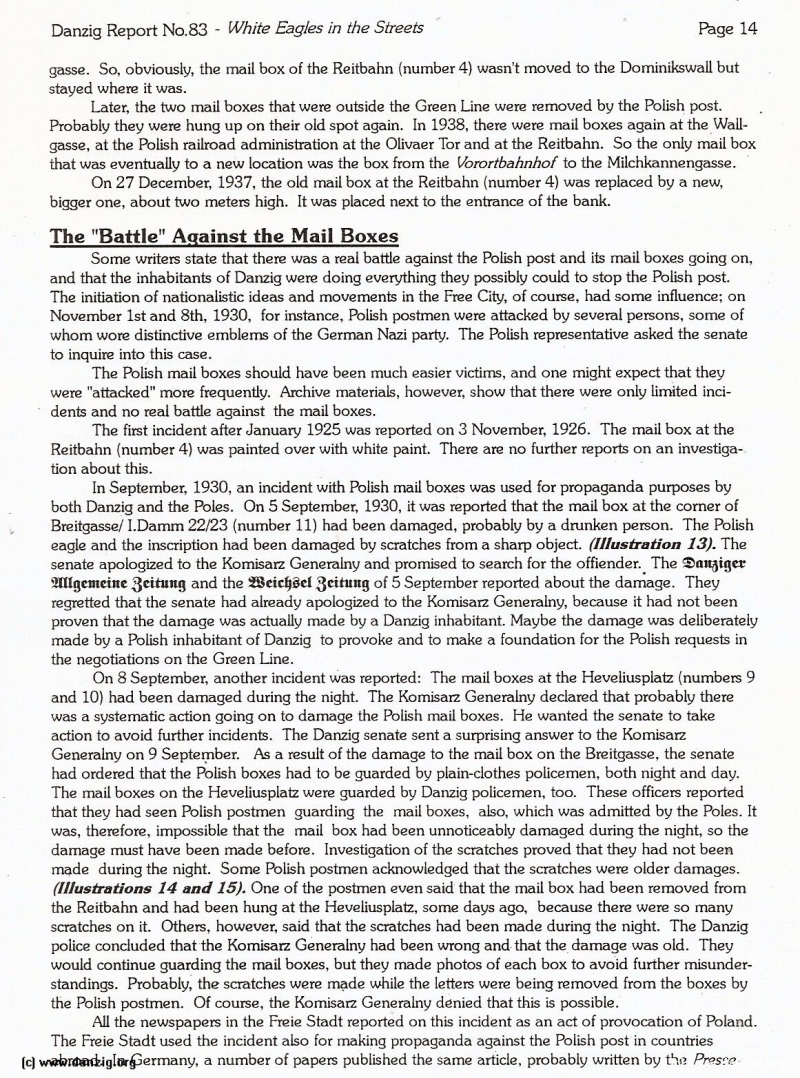
gasse. So, obviously, the mail box of the Reitbahn (number 4) wasn’t moved to the Dominikswall but stayed where it was.
Later, the two mail boxes that were outside the Green line were removed by the Polish post. Probably they were hung up on their old spot again. In 1938, there were mail boxes again at the Wallg asse, at the Polish railroad administration at the Olivaer Tor and at the Reitbahn. So the only mail box that was eventually to a new Location was the box from the Vorortbahnhof to the Milchkannengasse.
On 27 December, 1937, the old mail box at the Reitbahn (number 4) was replaced by a new, bigger one, about two meters high. It was placed next to the entrance of the bank.
The ‘Battle” Against the Mail Boxes
Some writers state that there was a real battle against the Polish post and its mail boxes going on, and that the inhabitants of Danzig were doing everything they possibly could to stop the Polish post. The initiation of nationalistic ideas and movements in the Free City, of course, had some influence; on November 1st and 8th, 1930, for instance, Polish postmen were attacked by several persons, some of whom wore distinctive emblems of the German Nazi party. The Polish representative asked the senate to inquire into this case.
The Polish mail boxes should have been much easier victims, and one might expect that they were ‘attacked” more frequently. Archive materials, however, show that there were only limited incid ents and no real battle against the mail boxes.
The first incident after January 1925 was reported on 3 November, 1926. The mail box at the Reitbahn (number 4) was painted over with white paint. There are no further reports on an investigat ion about this.
In September, 1930, an incident with F\\lish mail boxes was used for propaganda purposes by both Danzig and the Poles. On 5 September, 1930, it was reported that the mail box at the corner of Breitgasse/ I Damm 22/23 (number 11) had been damaged, probably by a drunken person. The Polish eagle and the inscription had been damaged by scratches from a sharp object. (Illusfrzifion 13). The senate apologized to the Komisarz Generalny and promised to search for the offiender. The an4igcr ftlgcnicinc 3citunq and the 3cicWd citun of 5 September reported about the damage. They regretted that the senate had already apologized to the Komisarz Generalny, because it had not been proven that the damage was actually made by a Danzig inhabitant. Maybe the damage was deliberately made by a Polish inhabitant of Danzig to provoke and to make a foundation for the Polish requests in the negotiations on the Green line.
On 8 September, another incident was reported: The mail boxes at the Heveliusplalz (numbers 9 and 10) had been damaged during the night. The Komisarz Generalny declared that probably there was a systematic action going on to damage the Polish mail boxes. He wanted the senate to take action to avoid further incidents. The Danzig senate sent a surprising answer to the Komisarz Generalny on 9 September. As a result of the damage to the mail box on the Breitgasse. the senate had ordered that the Polish boxes had to be guarded by plain-clothes policemen, both night and day. The mail boxes on the Heveliusplatz were guarded by Danzig policemen, too. These officers reported that they had seen Polish postmen guarding the mail boxes, also, which was admitted by the Poles. It was, therefore, impossible that the mail box had been unnoticeably damaged during the night, so the damage must have been made before. Investigation of the scratches proved that they had not been made during the night. Some Polish postmen acknowledged that the scratches were older damages. (!Ilusfrations 14 and 15). One of the postmen even said that the mail box had been removed from the Reitbahn and had been hung at the Heveliusplalz, some days ago, because there were so many scratches on it. Others, however, said that the scratches had been made during the night. The Danzig police conduded that the Komisarz Generalny had been wrong and that the damage was old. They would continue guarding the mail boxes, but they made photos of each box to avoid further misunders tandings. Probably, the scratches were made .thile the letters were being removed from the boxes by the Polish postmen. Of course, the Komisarz Generalny denied that this is possible.
All the newspapers in the Freie Stadt reported on this incident as an act of provocation of Poland. The Freie Stadt used the incident also for making propaganda against the Polish post in countries abroad. In Germany, a number of papers published the same article, probably written by the Presse
Danzig Report Vol. 1 - Nr. 83 - April - May - June - 1994, Page 16.
Hits: 3408
Added: 09/07/2015
Copyright: 2025 Danzig.org

